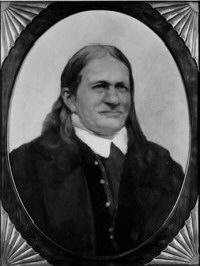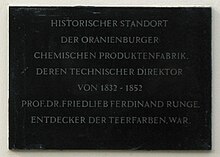Friedlieb Ferdinand Runge
Friedlieb Ferdinand Runge (born February 8, 1794 in Hamburg-Billwerder , † March 25, 1867 in Oranienburg ) was a German chemist . He is known for pioneering work on the investigation of substances from coal tar including aniline , the isolation of caffeine and pioneering work in paper chromatography .
Life
Runge was born as the third child of Pastor Johann Gerhardt Runge. For financial reasons, Runge was initially only able to attend elementary school. From 1810 to 1816 he was an apprentice pharmacist in the Ratsapotheke and the Löwen-Apotheke in Lübeck .
From 1816 to 1822 he studied at the universities of Berlin, Göttingen and Jena, first medicine, then chemistry at the University of Jena. In 1819 he received his doctorate as Dr. med. and in Berlin in 1822 as a doctor of philosophy with a thesis on the economically important indigo . In 1826 Runge became a private lecturer and in 1828 an associate professor of technology at the University of Breslau .
In 1832 he finished his university career and moved to Oranienburg , where he lived until his death to work at the chemical establishment Dr. Hempel, later Chemische Produkte-Fabrik Oranienburg, to work as an industrial chemist.
Act

Runge is known for his work on the technical utilization of coal tar , which at the time was produced in large quantities in the production of coal gas and coke and had to be disposed of as waste. He isolated, characterized and named substances from the coal tar, the most important among them: Kyanol ( aniline ), pyrrole , Leukol ( quinoline ), carbolic acid ( phenol ), rosolic ( Aurin ) - the basic building blocks for many products in the chemical industry during the second half of the 19 Century. August Wilhelm von Hofmann carried out more detailed studies of kyanol and leukol in 1843, while Auguste Laurent analyzed the elemental composition of carbolic acid. It was found that kyanol is identical to aniline, which, according to Carl Julius Fritzsche, forms when the anthranilic acid is heated. Runge carried out various experiments with aniline. When chlorinated lime solution was added, it took on a purple color. This reaction is still used today as a Rye chlorinated lime reaction for the detection of aniline. When mixed with oxygen, acids or bases, aniline forms red dyes. This was the first time Runge had produced tar dyes , which at that time were of no economic importance.
The beating mercury heart in the shape we know today was first described by Runge in 1829.
Other important substances that he first described are thymol and the alkaloids hyoscyamine and caffeine (on the advice of Johann Wolfgang von Goethe , who suspected an antidote to atropine in coffee beans ).
In schools in chemistry lessons, “pictures that paint themselves” are made based on his findings. These pattern images, also known as “ Runge images ”, are considered to be the forerunners of paper chromatography .
Aftermath
Runge's work became popular through the biographical novel Anilin by the National Socialist author Karl Aloys Schenzinger , published in 1936 . The book had a circulation of 920,000 copies during the Nazi era and was still successful in the post-war period.
The Friedlieb Ferdinand Runge Prize for unconventional art mediation has existed at the Berlinische Galerie since 1994 .
On the occasion of the 150th anniversary of Runge's death, a celebratory event took place in March 2017 at the drug manufacturer Takeda in Oranienburg. In a festive lecture, the Berlin pharmacologist Peter Oehme paid tribute to Runge's work and his work for the pharmaceutical location Oranienburg. At the same time, a Takeda Runge student prize was awarded. This was first awarded in September 2017 for excellent performance in the STEM subjects .
On his 225th birthday on February 8, 2019, the search engine Google paid tribute to Runge with a doodle for his discovery of caffeine.
The plant genus Rungia Nees from the acanthus family (Acanthaceae) is named after him.
Works
- Basic theory of chemistry for everyone: especially for doctors, pharmacists, farmers, manufacturers, tradespeople, and all those who want to acquire a thorough knowledge of this useful science . Graß, Barth et al. Comp., Breslau 1830 digitized
- The urge to educate substances. Illustrated in independently grown images (continuation of the sample images) . Self-published, Oranienburg 1855
Remarks
-
↑ Runge's year of birth is given differently in the literature as 1794 or 1795.
However, it is documented in the baptismal register of the Hamburg rural community St. Nikolai zu Billwerder . There was the following entry for 1794:“On February 8th, the local pastor, Mr. Johann Gerhard Runge, was born. from Hamburg and his wife Catharina Eliesabeth geb. Born to Heins. Born her son from St. Georg near Hamburg and baptized on the 16th. Names: Friedlieb Ferdinand: Gevattern: Frau Catharina Maria Dorothea Lagan geb. Kern, Jgfr. Johanna Helena Kern, Mr. Christian Friedlieb Raupach. "
- quoted from Berthold Anft: Friedlieb Ferdinand Runge his life and work. Dr. Emil Ebering, Berlin 1937 ( Treatises on the History of Medicine and Natural Sciences , Issue 23), p. 8, footnote 1.
Runge himself named his date of birth February 8, 1795 in a curriculum vitae in 1821, apparently he was wrong. A translation of this résumé is from Berthold Anft: Friedlieb Ferdinand Runge his life and work. Dr. Emil Ebering, Berlin 1937 ( treatises on the history of medicine and natural sciences , volume 23), p. 154–155, and taken over from there by Katrin Cura: Professorenklekse - Friedlieb Ferdinand Runge (1794–1867): discoverer of tar dyes and founder of paper chromatography . In: Gudrun Wolfschmidt (Ed.): Colors in cultural history and natural science . tredition, 2011, ISBN 3-8424-2200-8 , p. 268–293, here pp. 272–273 ( limited preview in the Google book search).
literature
- Richard Anschütz : Runge, Friedlieb Ferdinand . In: Allgemeine Deutsche Biographie (ADB). Volume 29, Duncker & Humblot, Leipzig 1889, pp. 684-686.
- Peter Oehme : Friedlieb Ferdinand Runge - pharmacologist, pharmaceutical and technical chemist. In: Dtsch. Apothekerzeitung , Volume 143, pp. 4991-4993, 1994.
- Peter Oehme and P. Wolf: The experiments of the "Doctor Gift". FF Runge - creative inventor in Oranienburg. In: Oranienburger Generalanzeiger, February 8, 1994.
- Wolfgang Asche: First tar colors from the Berlin region: the chemist Friedlieb Ferdinand Runge . In: Berlin monthly magazine ( Luisenstädtischer Bildungsverein ) . Issue 2, 1996, ISSN 0944-5560 , p. 52-54 ( luise-berlin.de ).
- Claus Priesner : Runge, Friedlieb Ferdinand. In: New German Biography (NDB). Volume 22, Duncker & Humblot, Berlin 2005, ISBN 3-428-11203-2 , p. 263 f. ( Digitized version ).
- Katrin Cura: Colorful world made of smelly mass. In: Practice of Natural Sciences: Chemistry in School. Vol. 60 (2011), No. 6, pp. 29-32.
- Christa Niedobitek, Fred Niedobitek: Friedlieb Ferdinand Runge. His life, his work and the chemical product factory in Oranienburg. Jacobs Verlag, Lage 2011, ISBN 978-3-89918-198-2 .
- Günther Harsch, Heinz H. Bussemas: Pictures that paint themselves. The chemist Runge and his “sample pictures for friends of the beautiful”. Suggestions for playing with colors . DuMont, Cologne 1985, ISBN 3-7701-1639-9
- A “contribution to the history of scientific discoveries” . In: The Gazebo . Volume 4, 1863, pp. 64 ( full text [ Wikisource ]).
Web links
- Literature by and about Friedlieb Ferdinand Runge in the catalog of the German National Library
- Friedlieb Ferdinand Runge: life and work . Jacobs Verlag website
Individual evidence
- ↑ J. Fritzsche: About the aniline, a new decomposition product of indigo . In: Annals of Chemistry . 36 (1), 1840, pp. 84-90, doi: 10.1002 / jlac.18400360108 .
- ↑ Hartwig Möllencamp, Bolko Flintjer, Walter Jansen: 200 years "Pulsating Mercury Heart " On the history and theory of a fascinating electrochemical experiment. In: CHEMKON. 1, 1994, pp. 117-125, doi: 10.1002 / ckon.19940010303 .
- ↑ Albert Gossauer: Structure and reactivity of biomolecules. Verlag Helvetica Chimica Acta, Zurich 2006, ISBN 978-3-906390-29-1 , p. 184.
- ↑ Volkhard Stürzbecher: Pictures that paint themselves . In: Spectrum of Science . Issue 4, 2001 ( Spektrum.de ). accessed on November 10, 2018
- ↑ Christian Adam : Read under Hitler Berlin 2010, p. 87 u. 323.
- ^ Friedlieb Ferdinand Runge Prize for unconventional art education berlinischegalerie.de
- ↑ Jens Minor: Friedlieb Ferdinand Runge: A funny Google doodle for the German chemist's 225th birthday. In: GoogleWatchBlog. February 7, 2019, accessed on February 7, 2019 (German).
- ↑ Lotte Burkhardt: Directory of eponymous plant names - Extended Edition. Part I and II. Botanic Garden and Botanical Museum Berlin , Freie Universität Berlin , Berlin 2018, ISBN 978-3-946292-26-5 doi: 10.3372 / epolist2018 .
| personal data | |
|---|---|
| SURNAME | Runge, Friedlieb Ferdinand |
| BRIEF DESCRIPTION | German chemist |
| DATE OF BIRTH | February 8, 1794 |
| PLACE OF BIRTH | Hamburg-Billwerder |
| DATE OF DEATH | March 25, 1867 |
| Place of death | Oranienburg |


